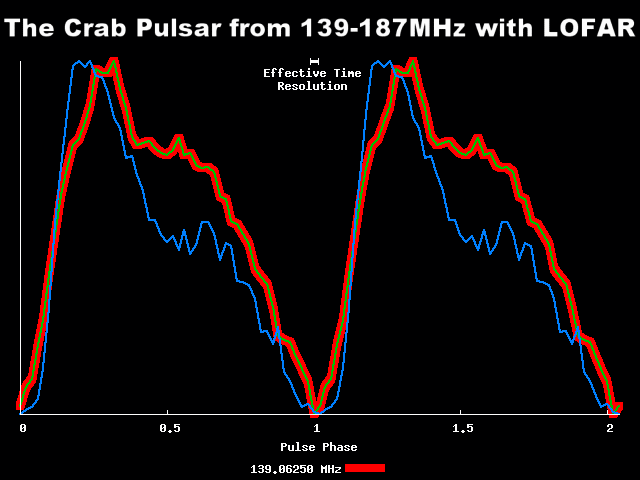Daily Image
22-12-2009The Crab Pulsar with LOFAR
| Submitter: | Tom Hassall (LOFAR Pulsar Working Group) |
| Description: | During Pulsar Busy Week 6 we took a 4 hour observation of the Crab Pulsar using 3 LOFAR HBA stations. Although we used 48MHz of bandwidth for the observation the pulsar was bright enough to be seen in a 1MHz band. This allowed us to break the observation up into 62 pieces in order to show how the pulse profile evolves at low frequencies. The red line shows the folded pulse profile in each of these 0.78125MHz pieces as it moves from the bottom of our band (the green line: 139MHz) to the top (the blue line: 187MHz). The dominant effect which can be seen here is scattering. As light from the pulsar travels through space on its way to Earth it interacts with charged particles in its path. Each particle which the light interacts with scatters it in a random direction, this results in many different paths which a beam of light can follow. The length of the different paths varies so light from the same pulse reaches Earth at different times depending on the path it takes. This broadens the pulse profile. As low energy photons are much more likely to interact with the ISM than those at high energies this effect is strongly frequency dependent. At low frequencies the pulse profile is extremely scattered and appears as a single wide pulse but as the frequency increases the scattering tail is reduced and the pulsar's interpulse can be resolved. The degree of scattering is theoretically believed to scale with frequency as nu^-4.4, but there is increasing evidence that it may differ from that. LOFAR observations with the simultaneous wide band and high sensitivity allows a detailed study of this scaling and could also potentially measure the inner and outer scale of turbulence in the interstellar medium. |
| Copyright: | Hassall, PWG |
| Tweet |  |
